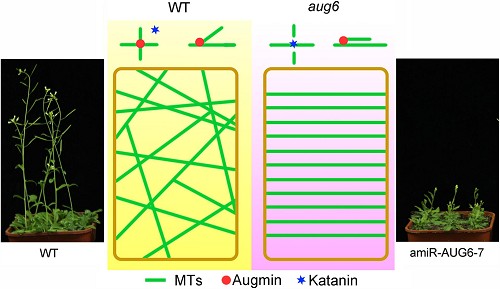The cytoskeleton system plays crucial roles in orientating cell division and in controllingthe cell expansionduring plant cell morphogenesis. Thus, it is intriguing to study the spatial architecture and dynamics of the cytoskeletonwhich are required for plant cell morphogenesis.
Plant cortical microtubules (MTs), which tightly attach to the plasma membrane and exhibit 2-dimensional arrays, orient the deposition of cellulose microfibrils in cell walls to determine the growth and morphogenesis of plant cells. Plant MT arrays are highly dynamic, and are constantly reorganized to generate specific architectures in response to developmental or external signals. How MT arrays are organized and precisely regulated in plant cells remain anopen question in the field of plant cell biology.

Figure 1. Augmin regulates MT dynamics and cell morphogenesis (Image by KONG’s group)
Prof. KONG Zhaosheng’s group at the Institute of Microbiology, Chinese Academy of Sciences, has previously discovered the mechanisms for augmin in establishing MT arrays (Current Biology, DOI:10.1016/j.cub.2014.09.053), and decoded the precise control of MT severing during dynamic MT organization (EMBO Journal, DOI:10.15252/embj.201796823), and uncovered the interplay of MTs with the actin cytoskeleton in trichome cell shape determination (eLife, DOI: 10.7554/eLife.09351).
Recently, they further revealed an unexpected role for augmin complex. In addition to trigger MT nucleation, augmin primarilyantagonizes katanin at microtubule crossovers to control the dynamic organization of plant cortical arrays.By living cell imaging, augmin particles wereobserved to preferentially localize at MT crossovers. And crossover-localized augmin primarily functions toprolong the maintenance of MT crossovers by inhibit katanin-mediated MT severing, thus regulates cell morphogenesis (see Figure 1). Further genetic and computational simulations confirmed roles for augmin in regulating the dynamics of MT arrays (see Gif image 1).

Gif image 1. Simulations of augmin in regulating MT dynamics ((Image by KONG’s group)
These findings have elucidated the spatial-temporal properties and the delicate regulation mechanism for MT arrays with four-dimensional view in living cells, and uncovered the new mechanism for augmin in regulating MT dynamics and cell morphogenesis. Their results provide important insights into precise regulation on plant cell morphogenesis.
These findings were published in Current Biology (http://www.cell.com/current-biology/fulltext/S0960-9822(18)30308-7).The first author of this paper is WANG Guangda, and the corresponding author is Prof. KONG Zhaosheng. This study was supported by the National Science Foundation of China, and the grants from the State Key Laboratory of Plant Genomics.
Contact:
Dr. Kong Zhaosheng
Department of Agricultural Microbiology and Biotechnology, Institute of Microbiology, Chinese Academy of Sciences, No.1 West Beichen Road, Chaoyang District, Beijing 100101
E-mail: zskong@im.ac.cn
